User manual
Manage Surveys
The "Manage Surveys" panel allows you to view and edit the surveys you have the access to. Here you can edit basic survey information, create new survey sessions, add users into the session, assign survey managers and proctors and make different survey reports. Also, you can modify the questions and grading scales for the surveys not yet published.
- Accessing the page
To access the "Manage surveys" page, navigate to the "Surveys" section in the main menu and select "Manage surveys" .
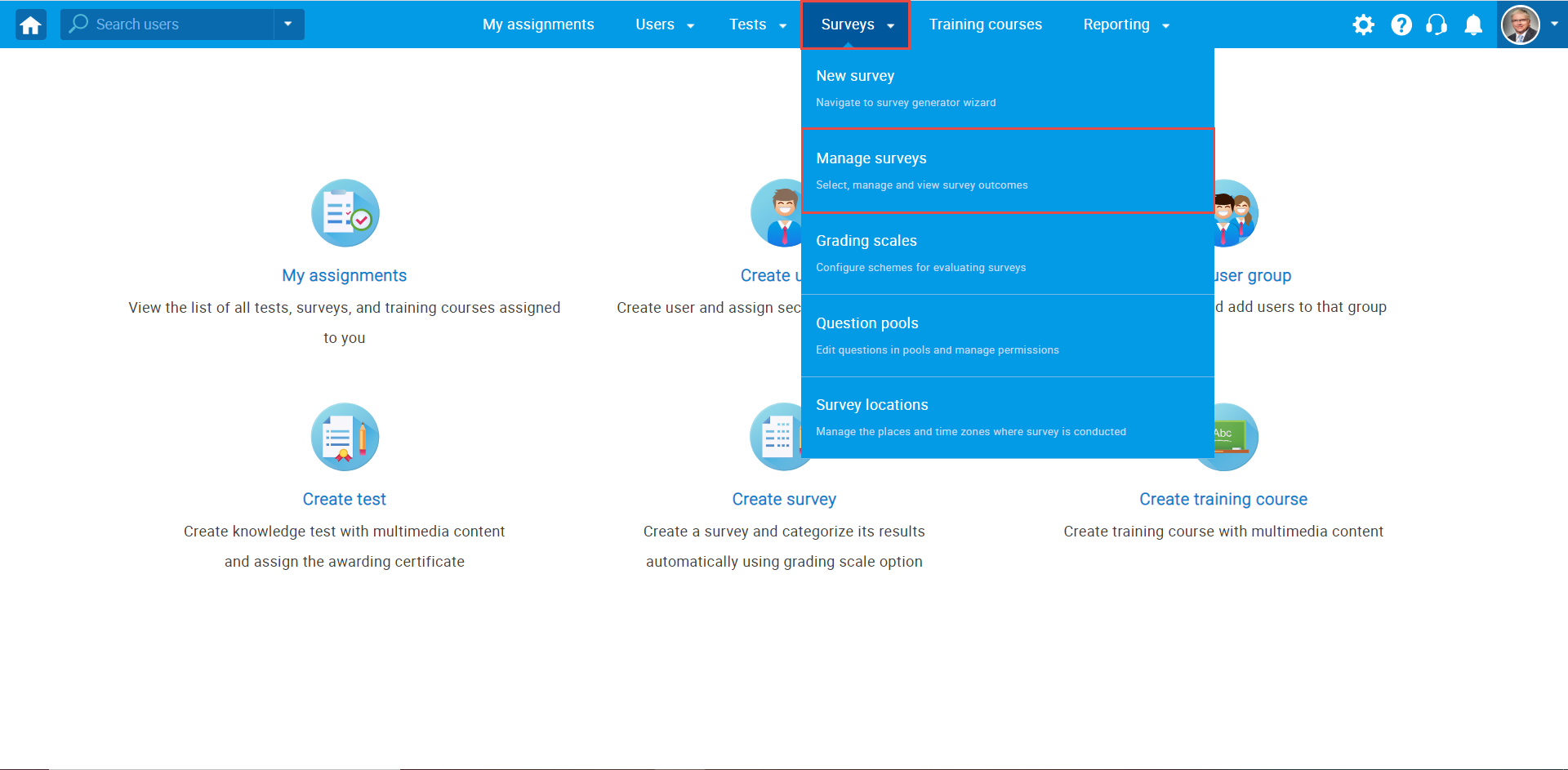
- Page layout
On the left side of the "Manage surveys" page, you will find a sidebar with a list of surveys organized into the following categories:
- "Drafts"- Surveys that are created, but not yet published. These surveys can be fully edited and modified.
- "Published"- Surveys that have been created and published. Questions and grading scales of the published surveys cannot be edited.
- "Suspended"- Suspended surveys are unavailable for taking and permanently disabled for any modifications. They can be used only for examining results.
Select the survey you would like to work with by clicking on it.
Also, you can create a new survey by clicking the "New Survey" button (number 4 in the picture below). If you need help with creating a new survey, please visit the New survey help section.
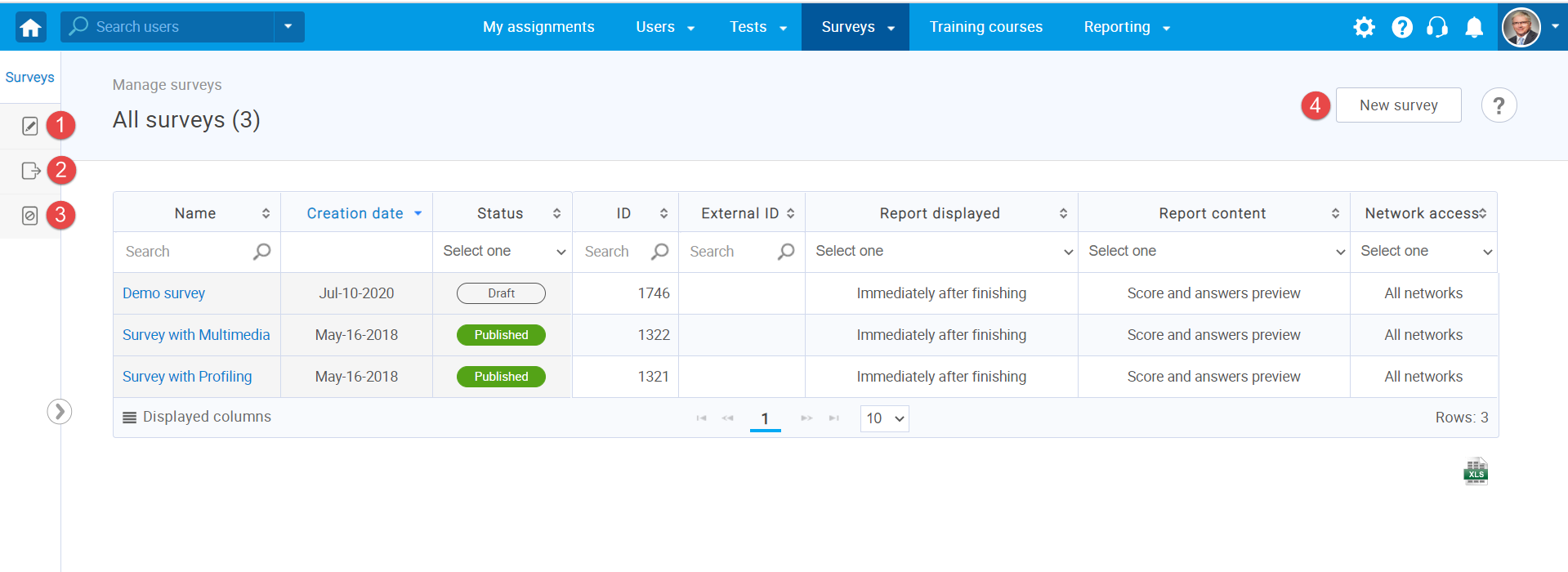
- Survey settings
Once you select a survey, you will be navigated to its "Settings" tab. Here you can view the main survey settings, explained below.
- Basic information
- "Survey ID" - a unique number of each survey, assigned automatically.
- "Name" - each survey must have a unique name.
- "Description" - this is an optional field where you can enter additional survey information.
- "Test label" - the optional label used for additional classification that will be displayed alongside this survey on every page and every exported report, e.g., "Classified", "Confidential"...
- "Instructions" - preview or edit the existing survey instructions. The assigned users need to acknowledge the instructions in a pop-up dialog before starting the survey.
- "Created by" - you can preview the profile of the user who created the survey
- "Creation date" - The date when the survey was created.
- "Updated by" - you can preview the profile of the user who updated the survey.
- "Update time" - The date when the survey was updated.
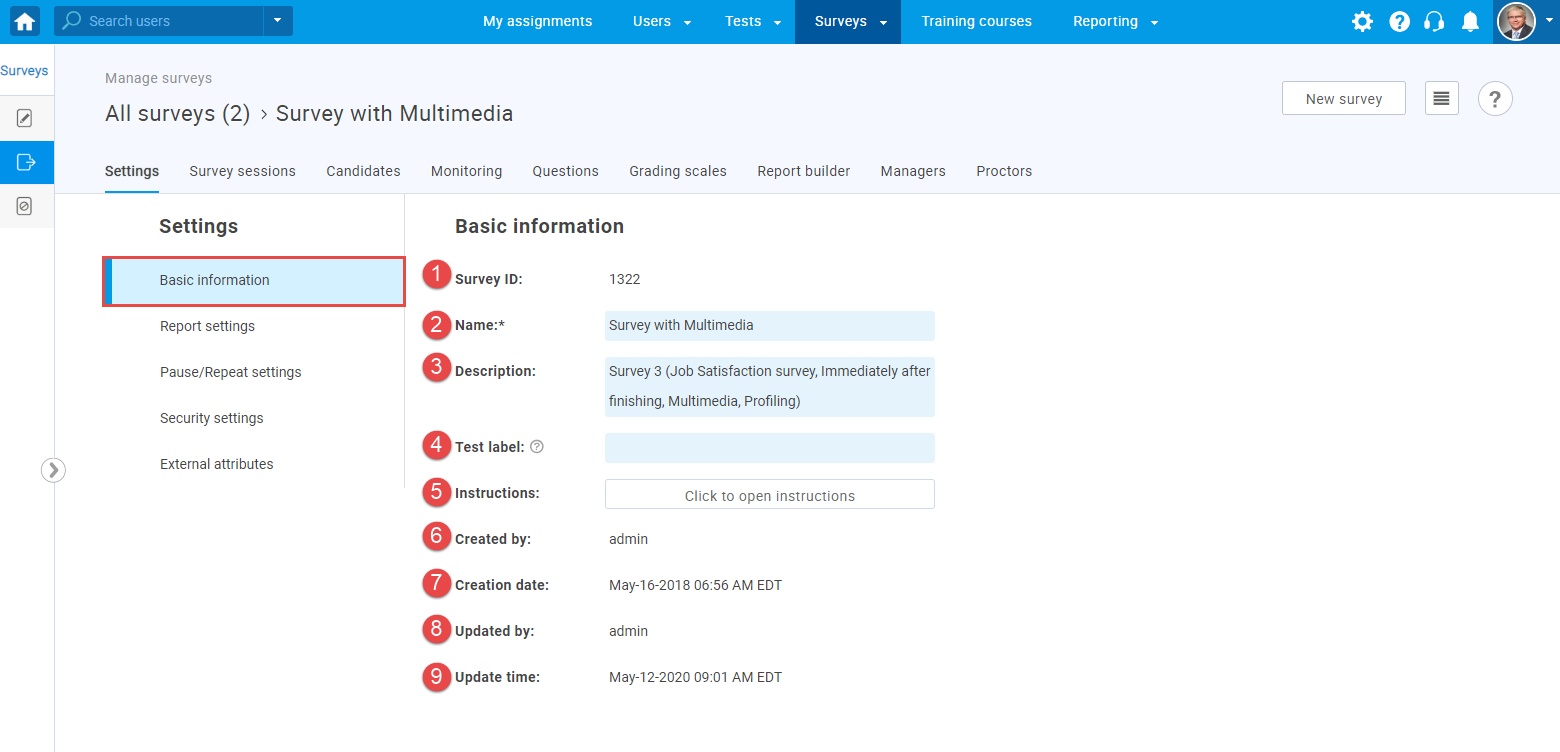
- Report settings
- "Show report"- choose when will the report be displayed to the users:
- On manager's approval - the users will see the report after the manager of the survey approves it.
- Immediately after finishing- the user will see the report immediately after completing the survey.
Note: Depending on the settings, some questions require a manager's approval to be available in the report.
- "Report content" - define what will the users see in the survey's report:
- "Score and answer preview" - the user will see his score, preview of all questions, his answers and correct answers.
- "Score only" - the user will see only his score.
- "Configure report lifespan" - define how long will the report be available to the users.

- Pause/Repeat settings
By enabling the "Allow survey continuation" option, the users will be able to save their answers, take a pause, and continue the survey within the surveys' availability period. The availability period is set later in the survey session creation process.
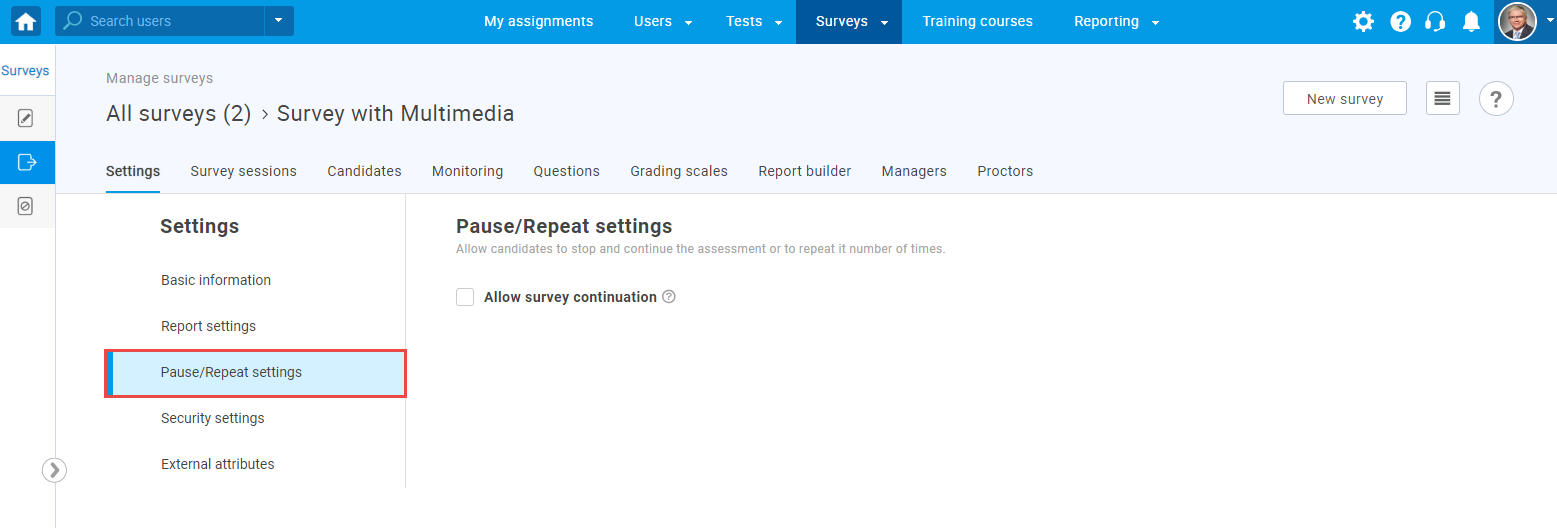
- Security settings
- "Enable browser lockdown" - the users will not be able to cut, copy, save or print anything from the screen during the survey-taking process. Also, the web browser will be in the full-screen mode, and if the users try to minimize it, the survey attempt will be terminated.
- "Network access" - limit the access to the survey only to people within your local (internal) network.
- "Automatically logout candidate after finishing" - the application will automatically logout the user upon completing the survey.
- "Require updating personal information" - when starting the survey, a screen with the user's personal information will appear. The user can confirm the validity of the information or make necessary changes in order to start the survey.
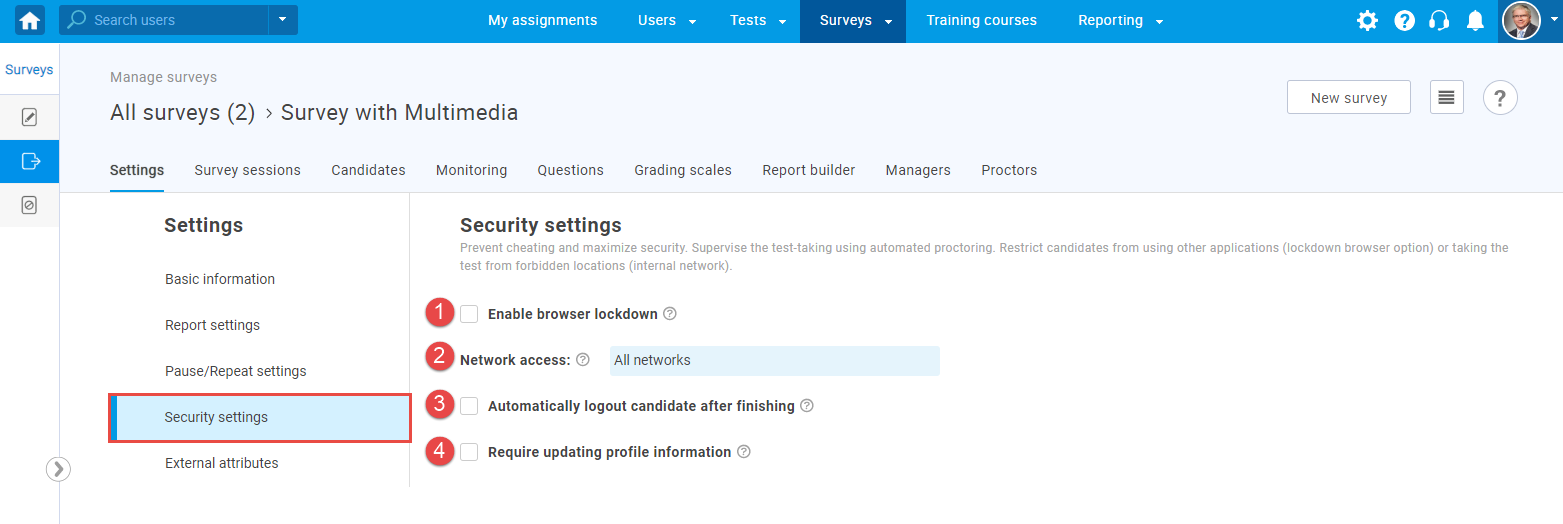
- External attributes
- External ID - a survey’s unique identifier used for integration with external systems.
- Data Source - the name of the external system.
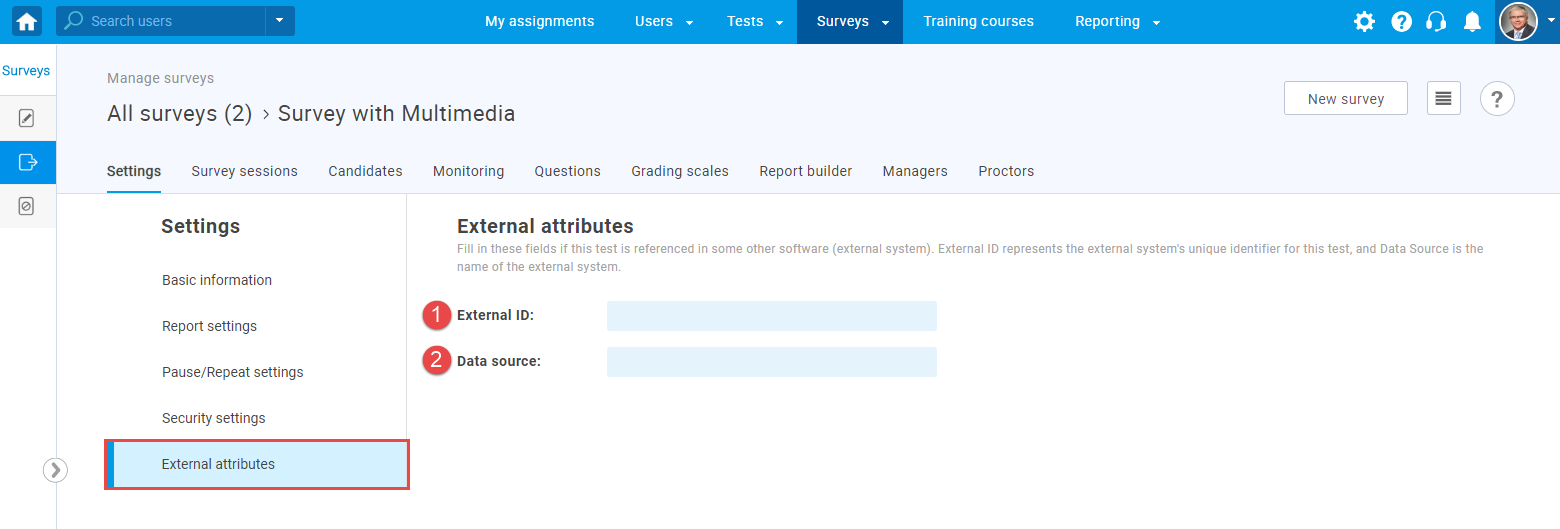
- Surveys sessions
Survey sessions allows you to organize a survey for users located at different time zones, states, continents, etc.
To create a new survey session:
- Click the "New survey session" button or
- Click the "Load sessions" option to upload survey sessions by using the predefined excel template.
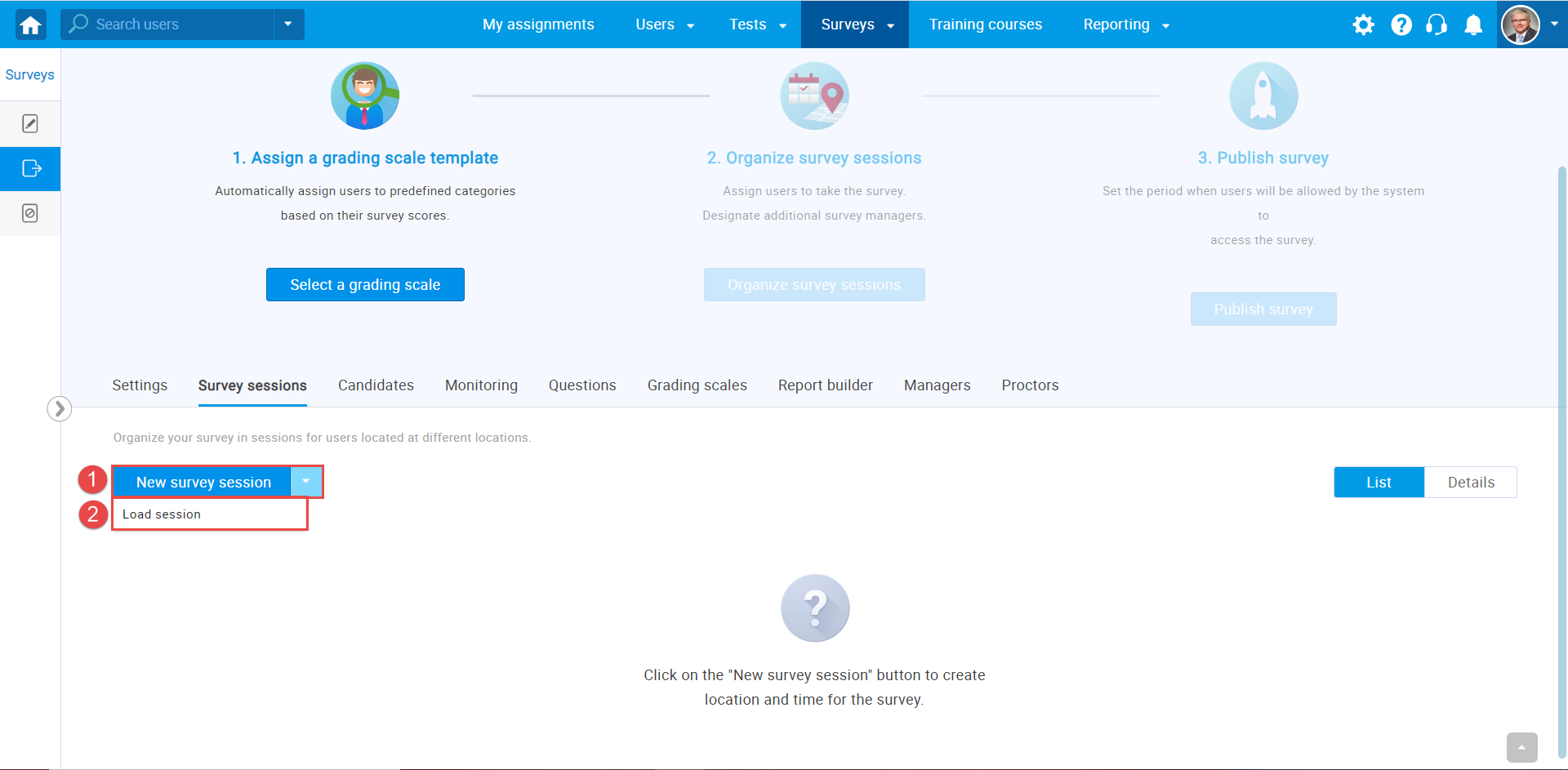
- Creating and editing survey sessions
To create or edit a survey session, click the "New survey session" button and then:
- Enter the session's name
- Choose one of the previously defined survey locations. If you need more information on how to create a new survey location, please visit Survey locations.
- The field displays the time zone of the user creating the session. The dates and times below are defined according to this time zone.
- Enter the date and time when the session will become available to the users.
- Enter the date and time by which the session will be available to the users.
- If you use this option, only users from a group you choose will be able to enroll in the session. Upon selecting the group, you will have to hand-pick the group members who will have access to the session or turn on the option of Self-enrollment to grant access to the whole group.
- If this option is enabled, users will have open access to the survey, and a survey manager won't have to assign them manually. The users can access the session from the "My assignments" panel.
- If the "Locked" option is enabled, a user will be able to start the survey only by entering the "Session password".
- This option is optional and used for integration with external systems.
- This option is optional and used for integration with external systems.
- Click the "Save" button to save the session.
- Click the "Cancel" button to close the "New survey session" window and discard your changes.
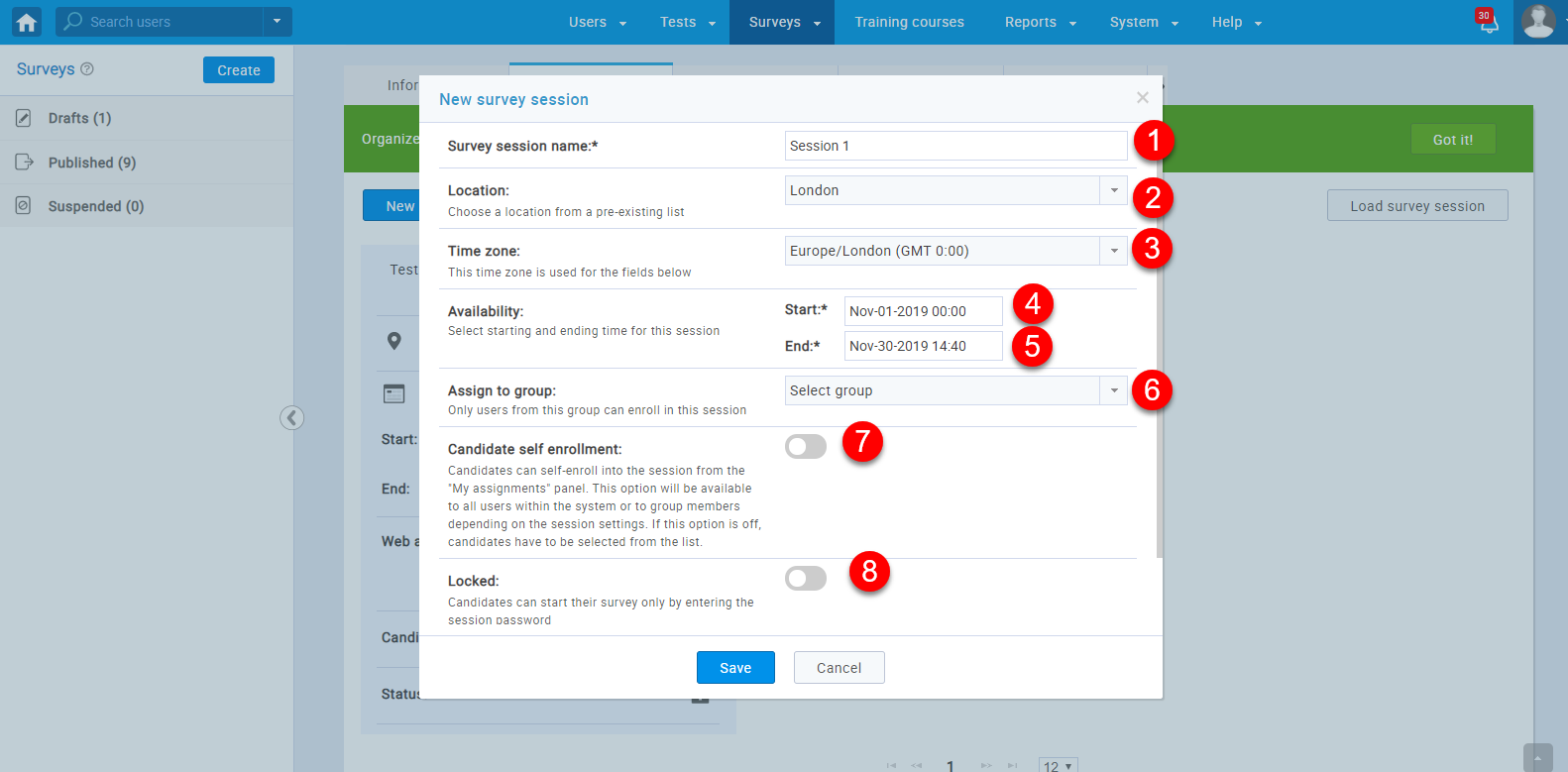
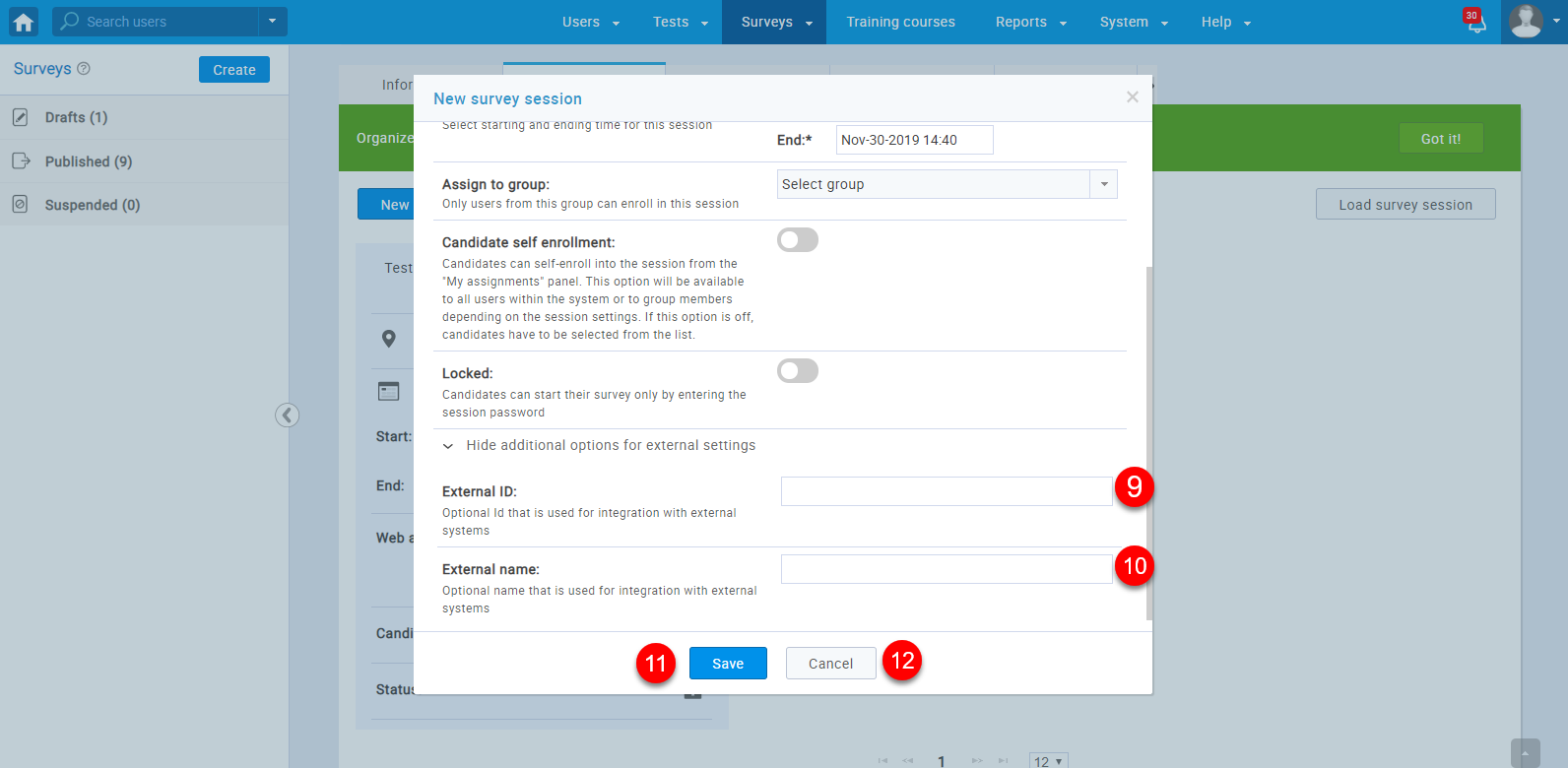
After creating a session, you will be able to see it in the "Survey sessions" tab with the following options and information:
- Click the pencil icon to edit the existing survey session.
- Click the trash can icon to delete a session, and make it unavailable for users.
- The location of the session.
- The date and time when the session will become available to the users.
- The end date by which the session will be available to the users.
- The link for direct access to the survey session.
- The number of assigned users. A new user can be added to the session by clicking the plus icon.
- The status of the session. It can be locked or unlocked. Click the padlock icon to lock/unlock the session once you create/enter the password.
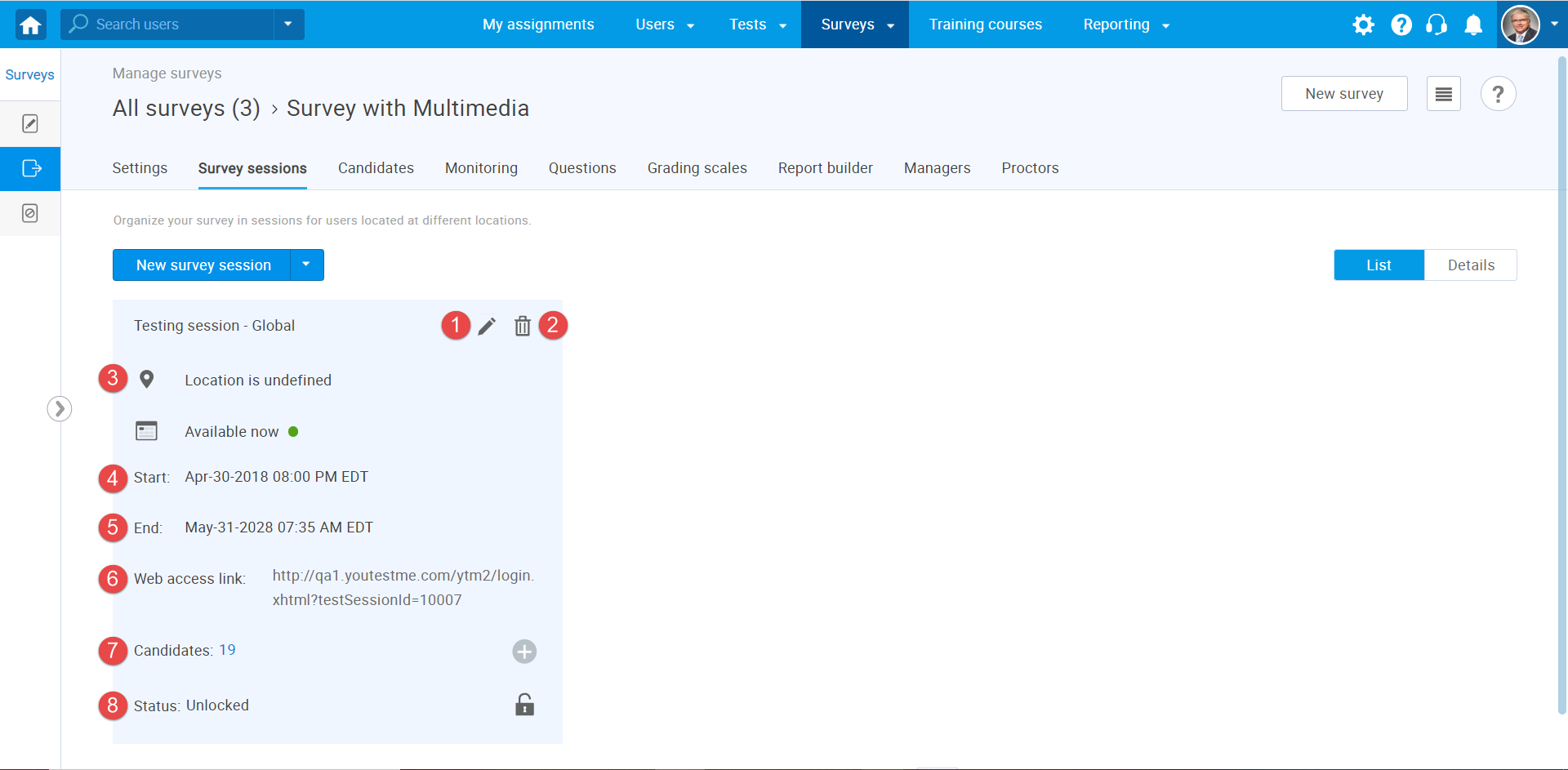
- Loading survey sessions using an Excel template
Loading survey sessions using an Excel template allows you to organize one or more sessions for a desired survey quickly and efficiently.
To load survey sessions using predefined Excel template, follow these steps:
- Click the "Load session" option.
- Download an Excel template which you should fill in, by clicking the "Excel template" link.
- Download detailed instructions on how to fill in the template by clicking the link.
- Click the "Select file" button to choose the template that you filled in.
- Click the "Upload" button to add survey sessions into the GetCertified application.
- Click the "Cancel" button to discard changes.
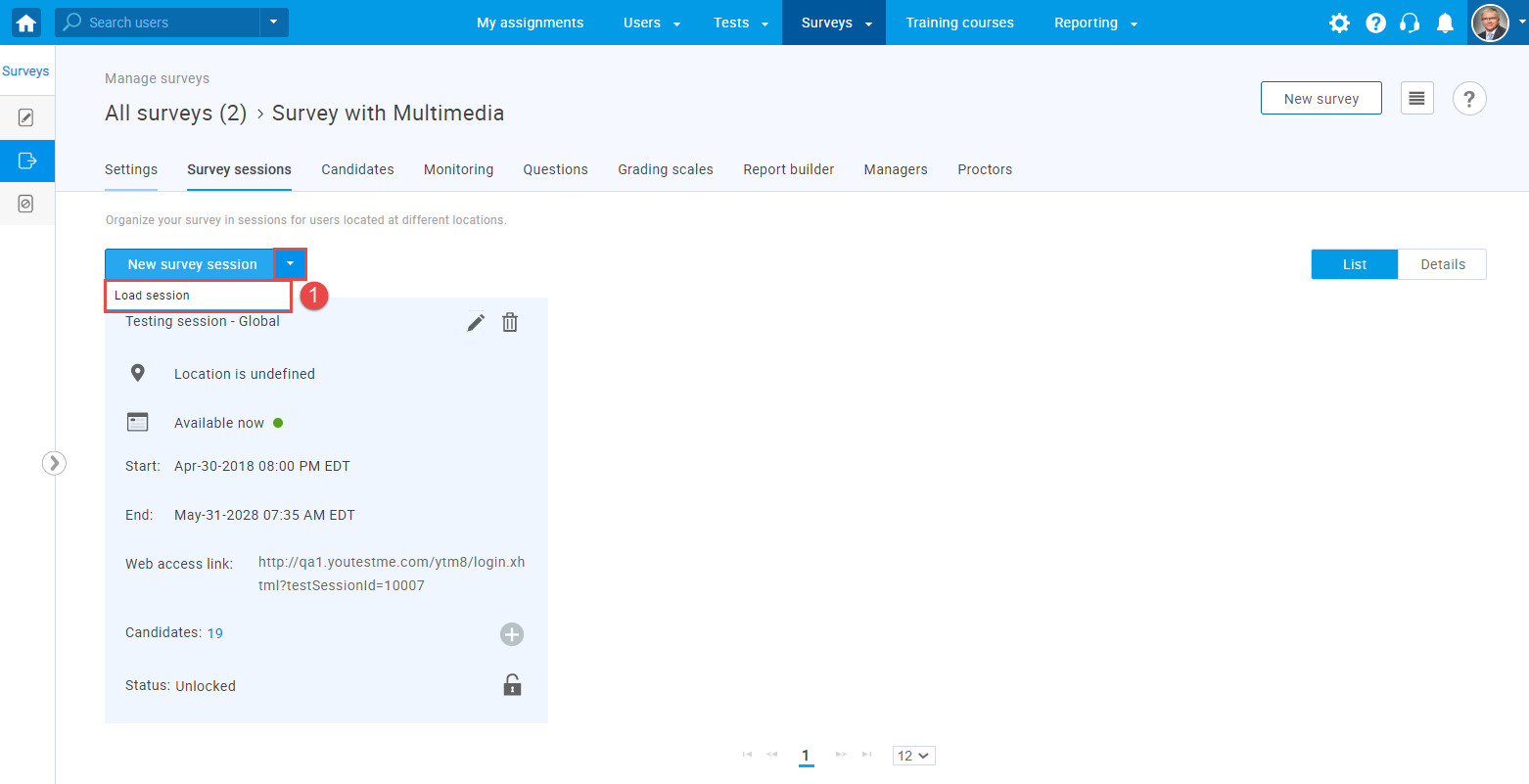
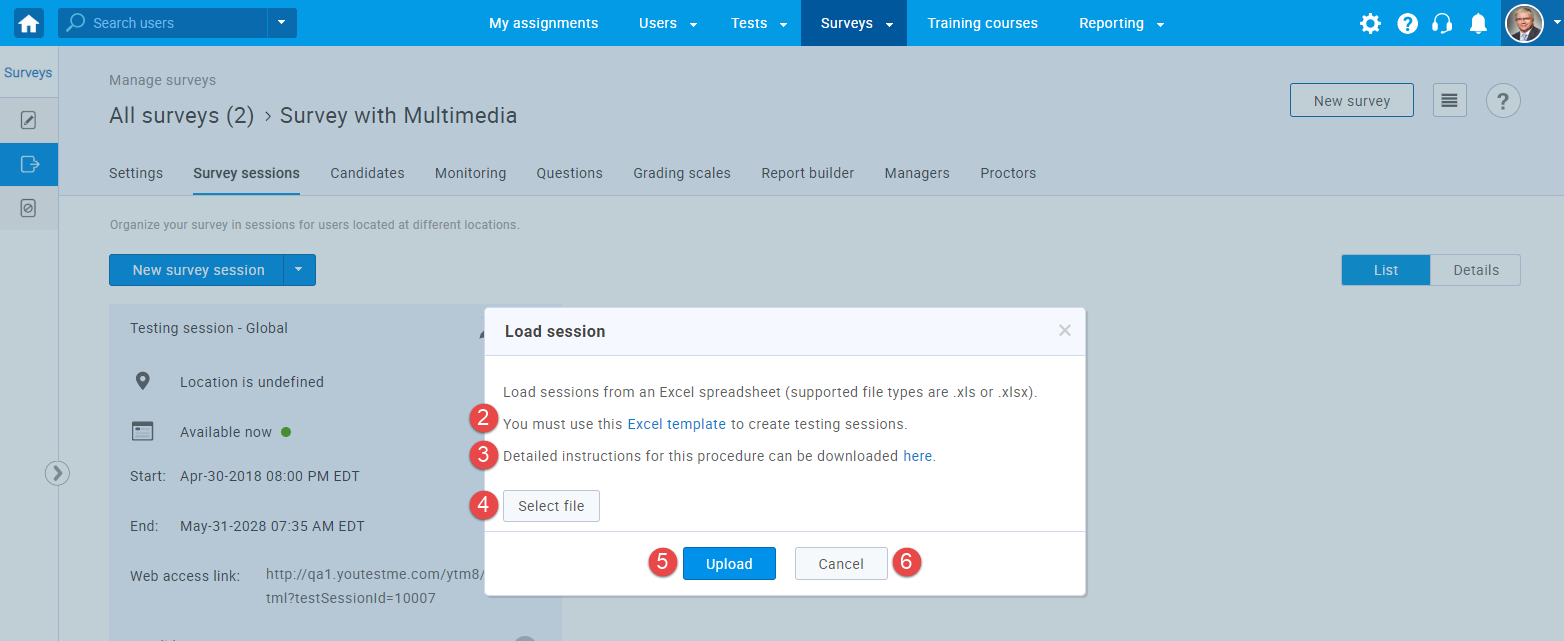
This tab allows you to assign candidates to the survey session. The candidates will be able to access and complete the survey within its availability period.
To add candidates to the survey session:
- Choose the session you want to assign candidates to.
- Click the "Assign candidates" button.
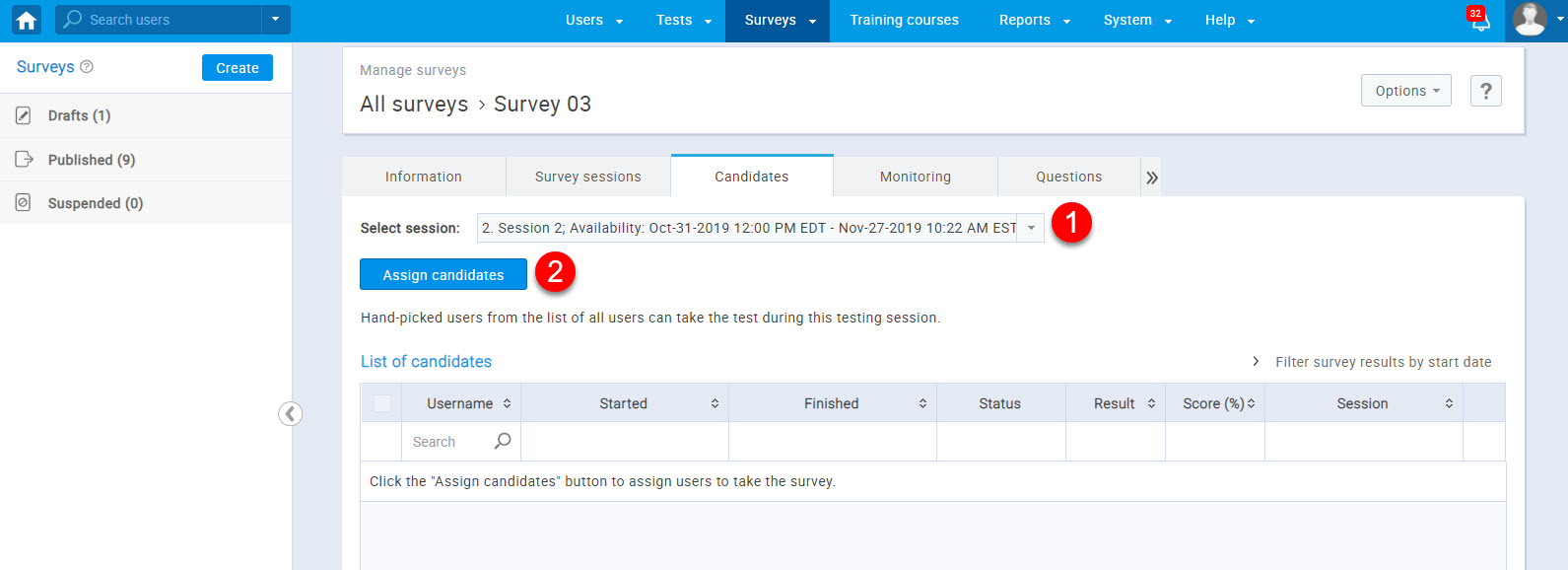
After that, a pop-up window will appear where you should:
- Select the users you want to add to the session.
- Click the "Confirm" button.
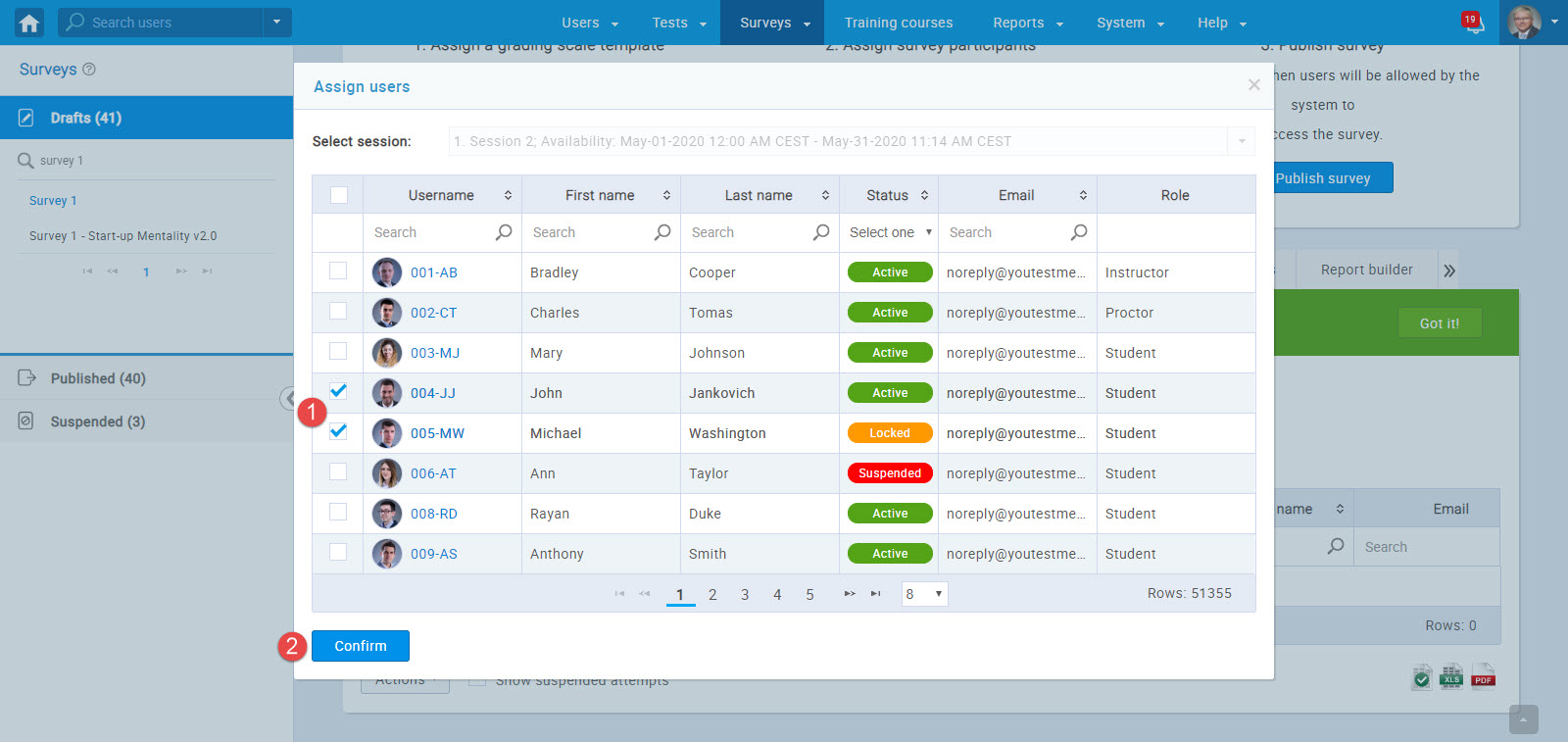
The assigned candidates will be displayed in the table which contains the following options:
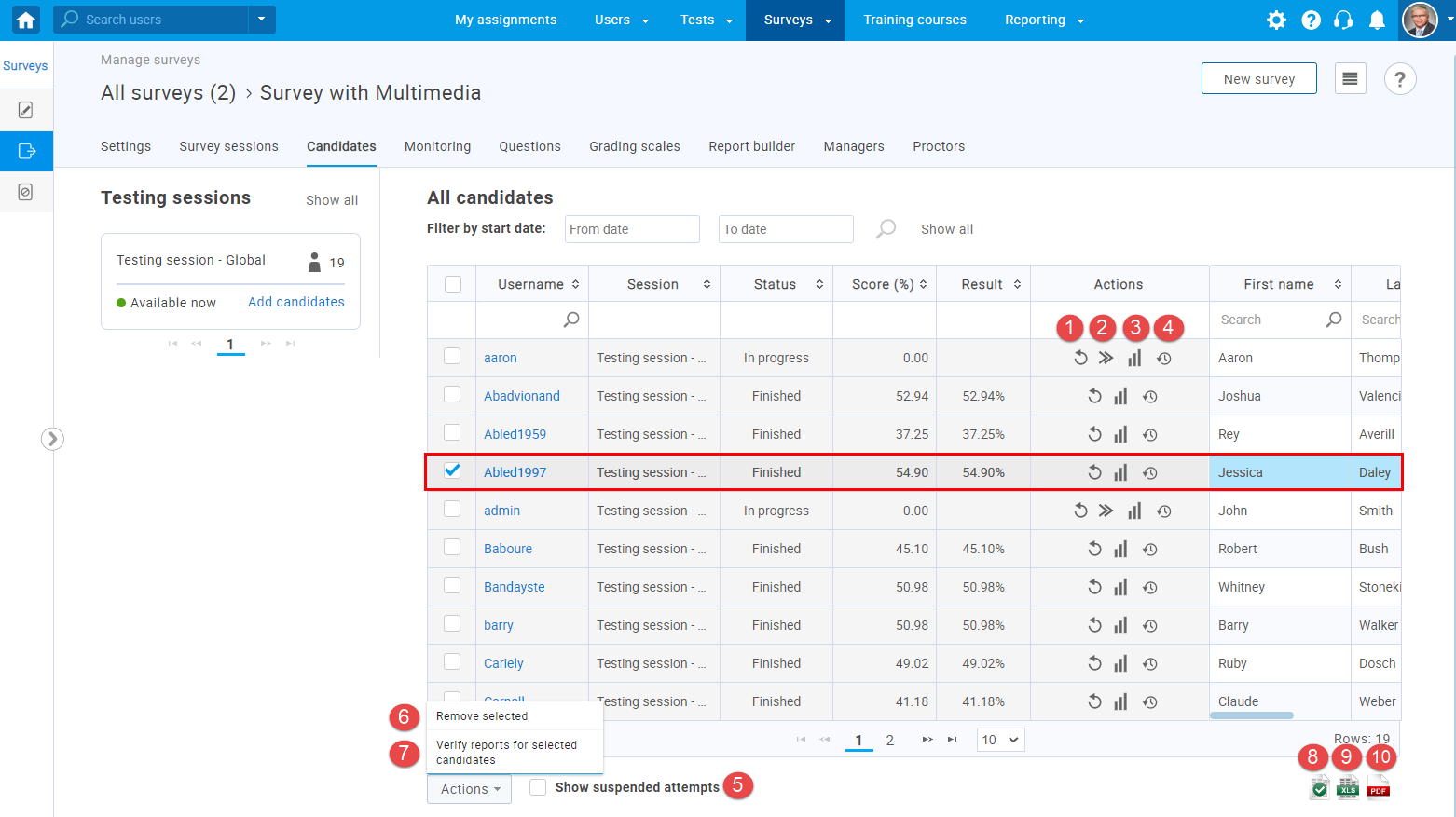
- Clicking this button will reset a candidate's survey attempt. That user will be able to do the survey again.
- This button is displayed only if the candidate left the survey he started. Clicking this button will allow the candidate to continue the survey.
- Clicking this button will open the candidate's personal report. The report contains the candidate's result, preview of questions and answers, and points for manually graded questions.
- This option allows you to preview the candidate's previous attempts. If the candidate has no previous attempts, the icon will not be visible.
- By enabling this option, you will be able to preview the suspended attempts.
- To remove candidates from the survey session, you should:
- Select the candidates you want to remove, as shown in the picture above.
- Click the "Action" button and choose "Remove selected".
- To verify the candidates’ reports:
- Select the candidates whose reports you want to verify.
- Click the "Action" button and choose "Verify reports for selected candidates".
This option allows you to update the verification date of the candidate's report to the current date. Verification of candidates’ reports allows you to export the Completion status excel file that contains a list of verified users with their verification dates and completion statuses.
- Download the Completion status excel file with a list of verified users with their verification dates and completion statuses.
- Download an Excel file with important information about candidates, their survey-taking attempts, and results.
- Download a PDF file with important information about candidates, their survey-taking attempts and results.
You can choose which columns will be displayed in the table by clicking the "Displayed columns" option.
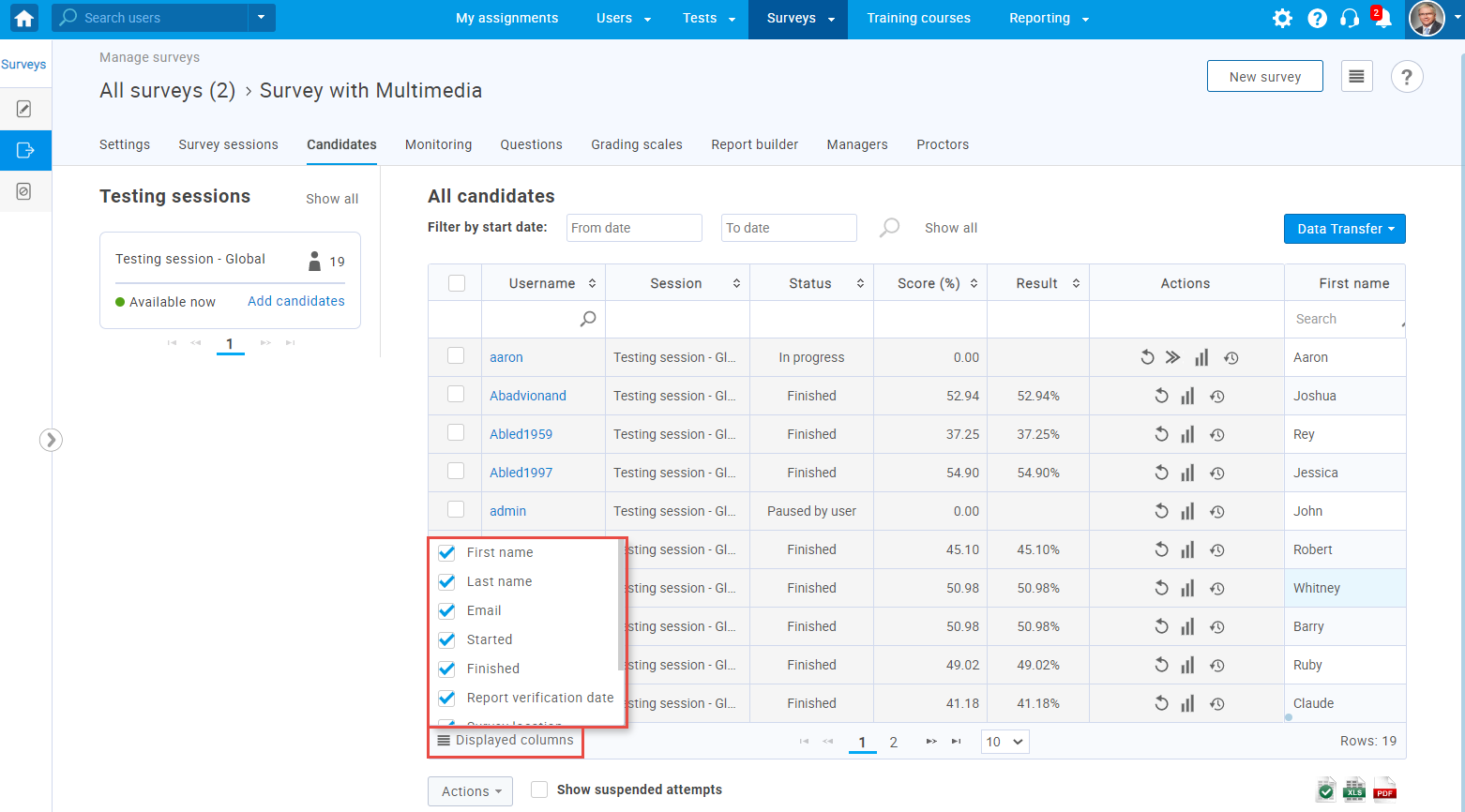
On this screen, you can monitor candidates' progress in the survey you are assigned to as a proctor. Also, you can see candidates' scores, their answers, time they spent on each question, etc.
You can also pause the survey session on this screen. To do so:
- Choose the session you want to pause by clicking on the desired session on the left side.
- Click the "Pause" button.
Once you pause the session, the "Continue" button will appear. Later, you can resume the session by clicking this button.
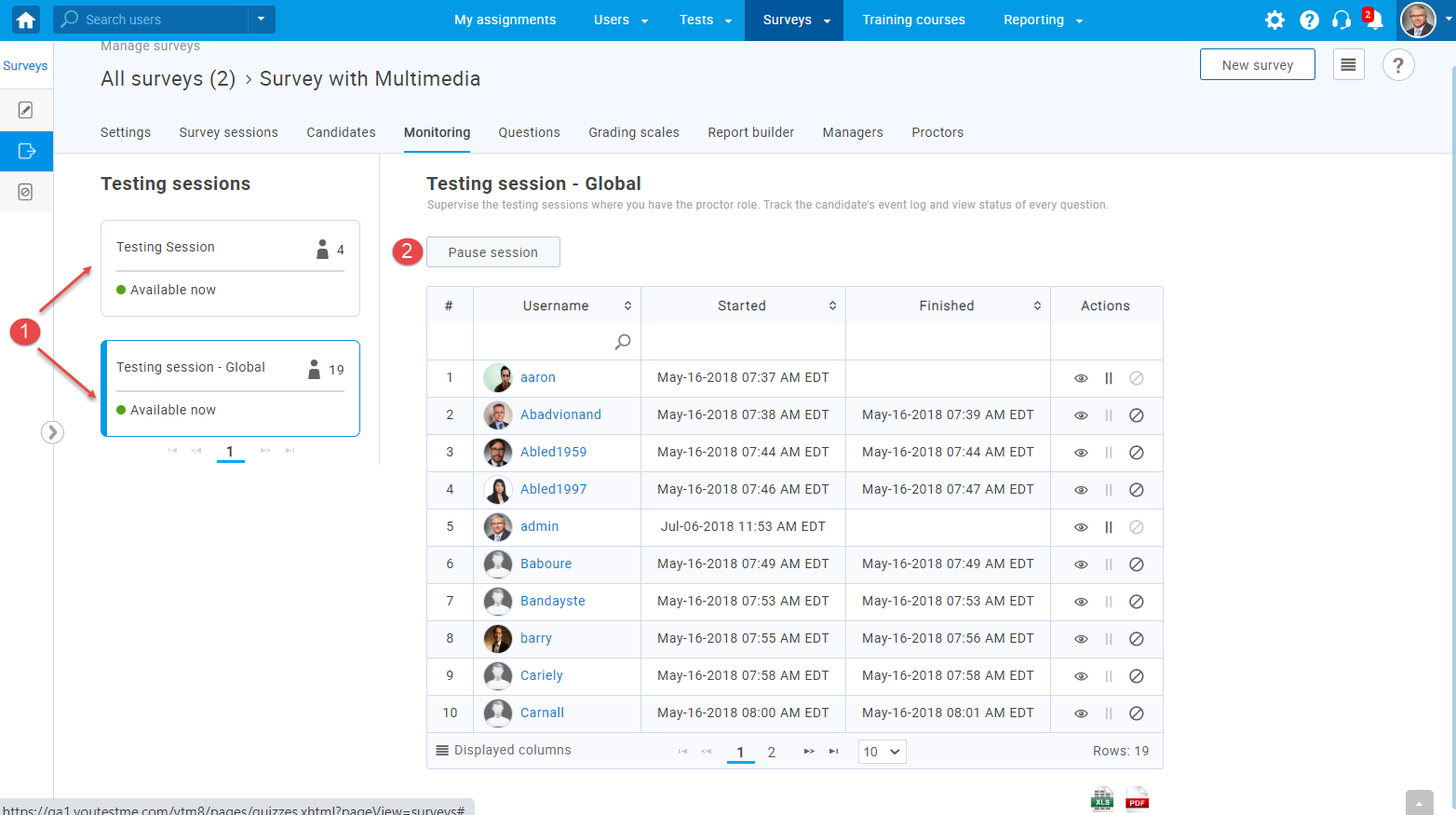
All monitoring options are explained below:
- The "Details" button allows you to view the progress of a particular user. By clicking this button, you can track the candidate's event log and view the status for each survey question.
- The "Pause" button allows you to pause the survey for each candidate separately. You can also send a message to the candidates with an explanation for survey pausing.
- This option allows you to prohibit a candidate from taking the survey. To allow the candidate to take the survey later on, click again on the same icon.
- This option allows you to download an Excel file with each user’s start and finish time of survey-taking.
- This option allows you to download a PDF file with each user’s start and finish time of survey-taking.
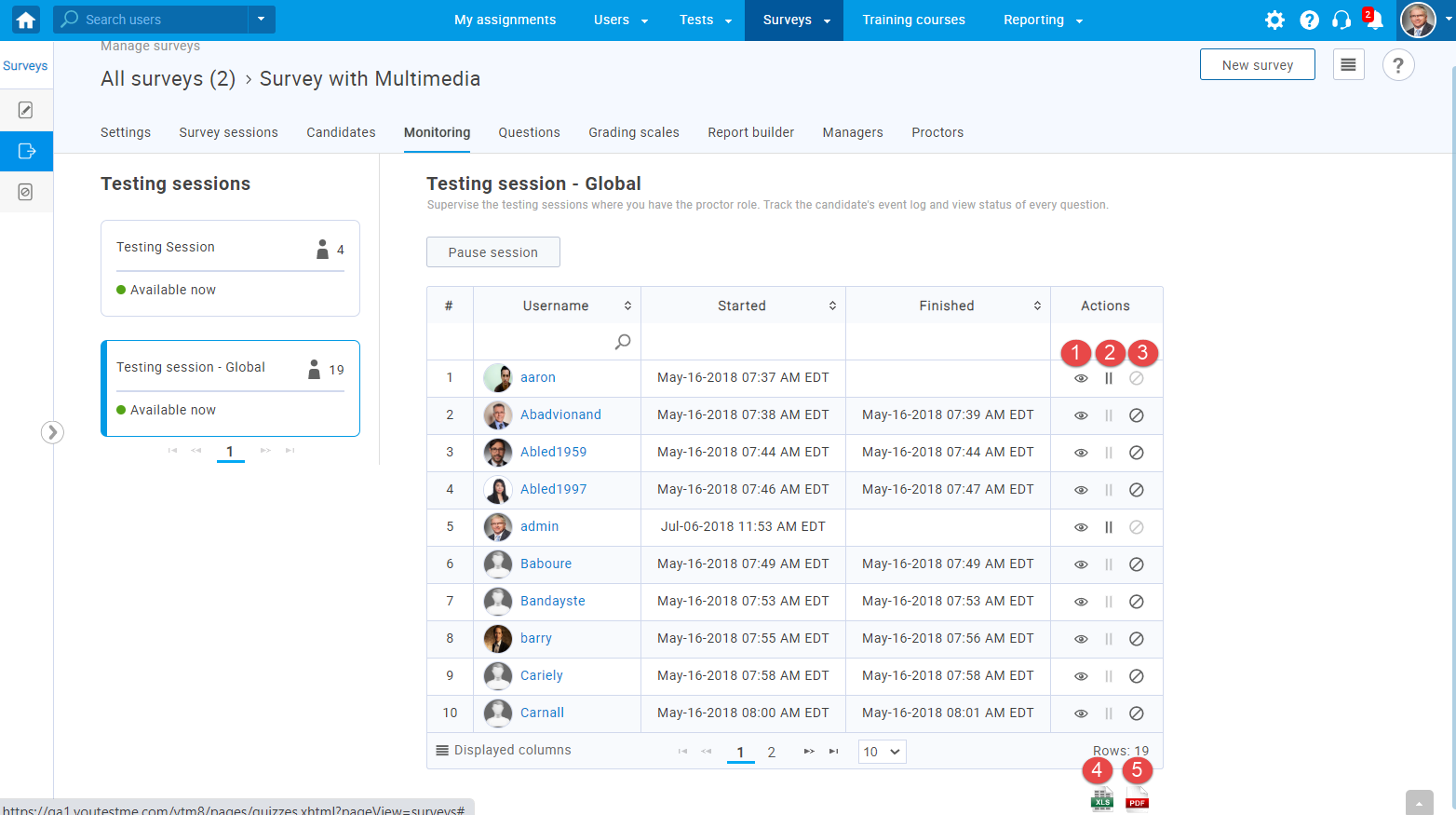
If you click the ‘’Details’’ icon to view a candidate’s progress, the following options will be available:
- "Action logs" - all actions with timestamps for this survey attempt will be displayed.
- "Question status" - shows the time a user spent on each question.
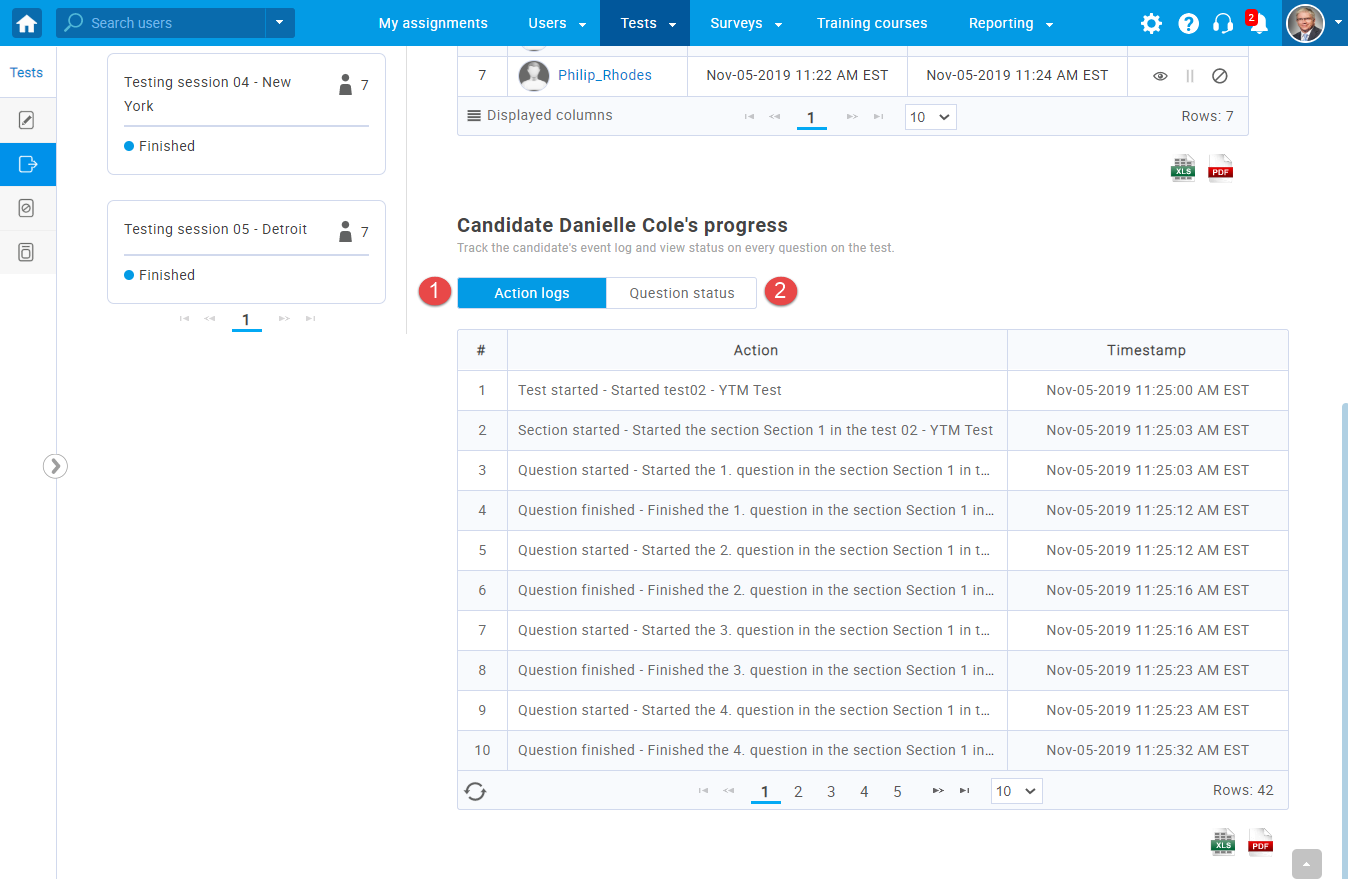
If the survey has more than one section, you can view the time a user spent on each section, and the time spent on each question within the section.
When clicking the "Question status" option:
- Choose a section by clicking the "View section progress" option in the Action column.
- A table with the statuses of all questions within the selected section will appear.
In the "Questions" tab, you can view and edit the survey questions. If the survey has not been published yet, you can still add, modify, or remove questions from the survey. After publishing, such modifications are no longer possible.
- Survey not published
If the survey is not published, the following options are available:
- Randomize the order of questions. Each user will get questions in a different order.
- Randomize the order of answers for each question. Each user will get a different answer order for the same question.
- Clicking the "Import questions" button, allows you to add additional questions from pools (groups of questions). You should choose the desired pool and select the questions you want to add.
- Clicking the "New question" button, allows you to add new questions into the survey manually. For more information on how to create each question type, please visit Question types.
- Reorder the questions by changing the number in the highlighted field.
- These options allow you to preview, edit or delete added questions.
- Export the list of questions as Excel/PDF file.
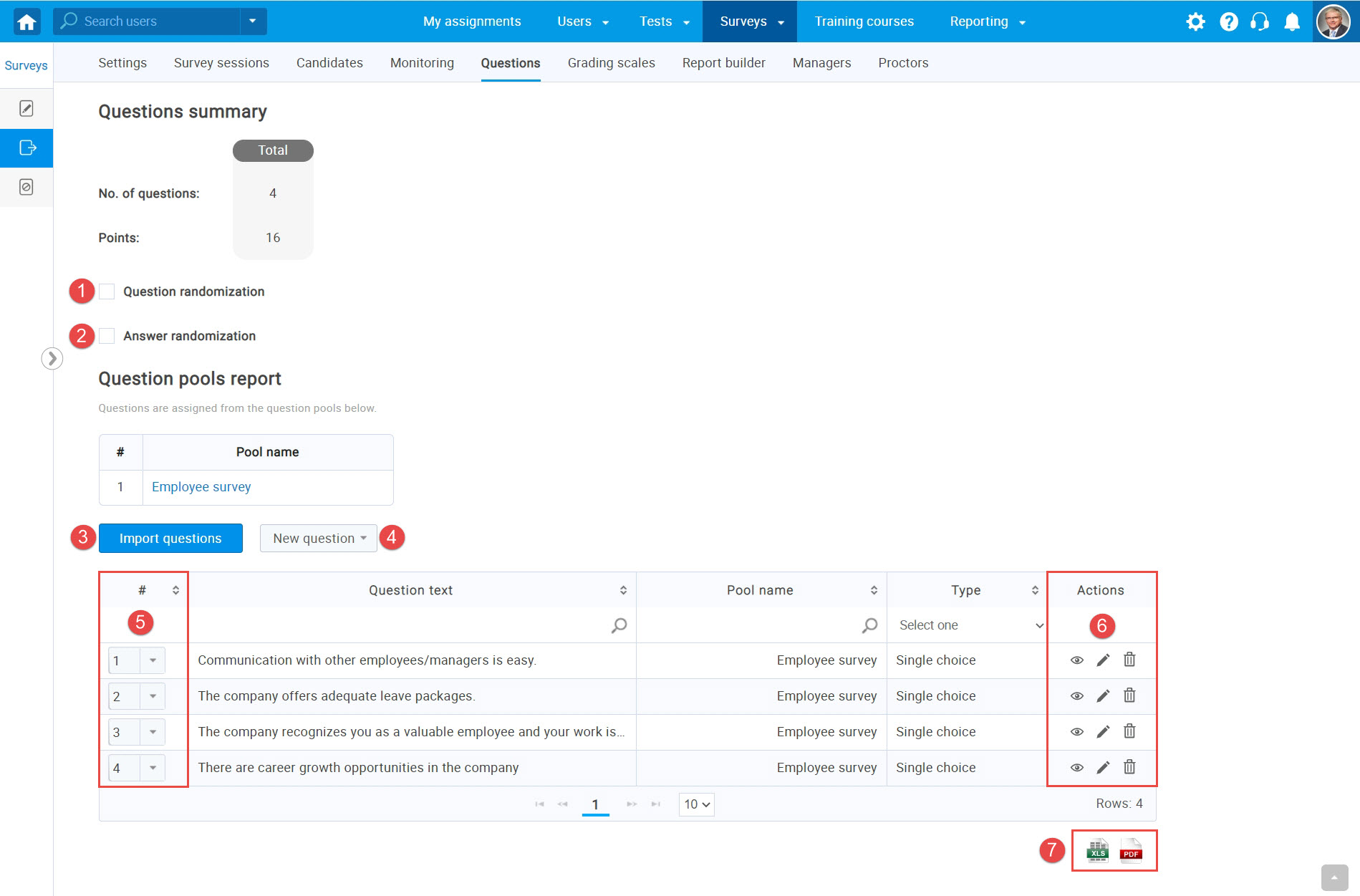
- Survey published
If the survey has been published, you can examine the statistics for each question by clicking the "Details" icon in the "Action" column.
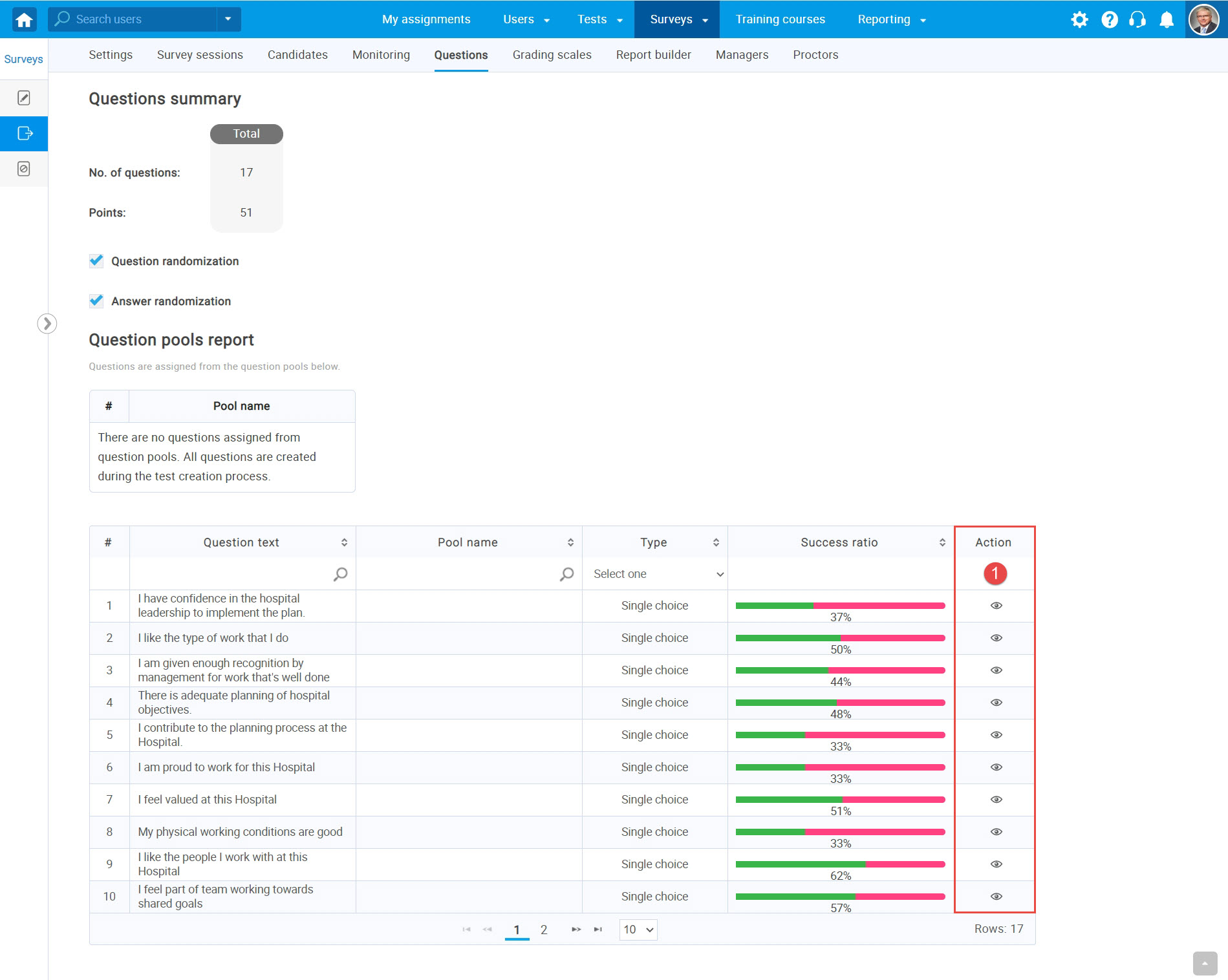
This option allows you to see detailed information about the selected question in the table- its text, answers, settings, and statistics.
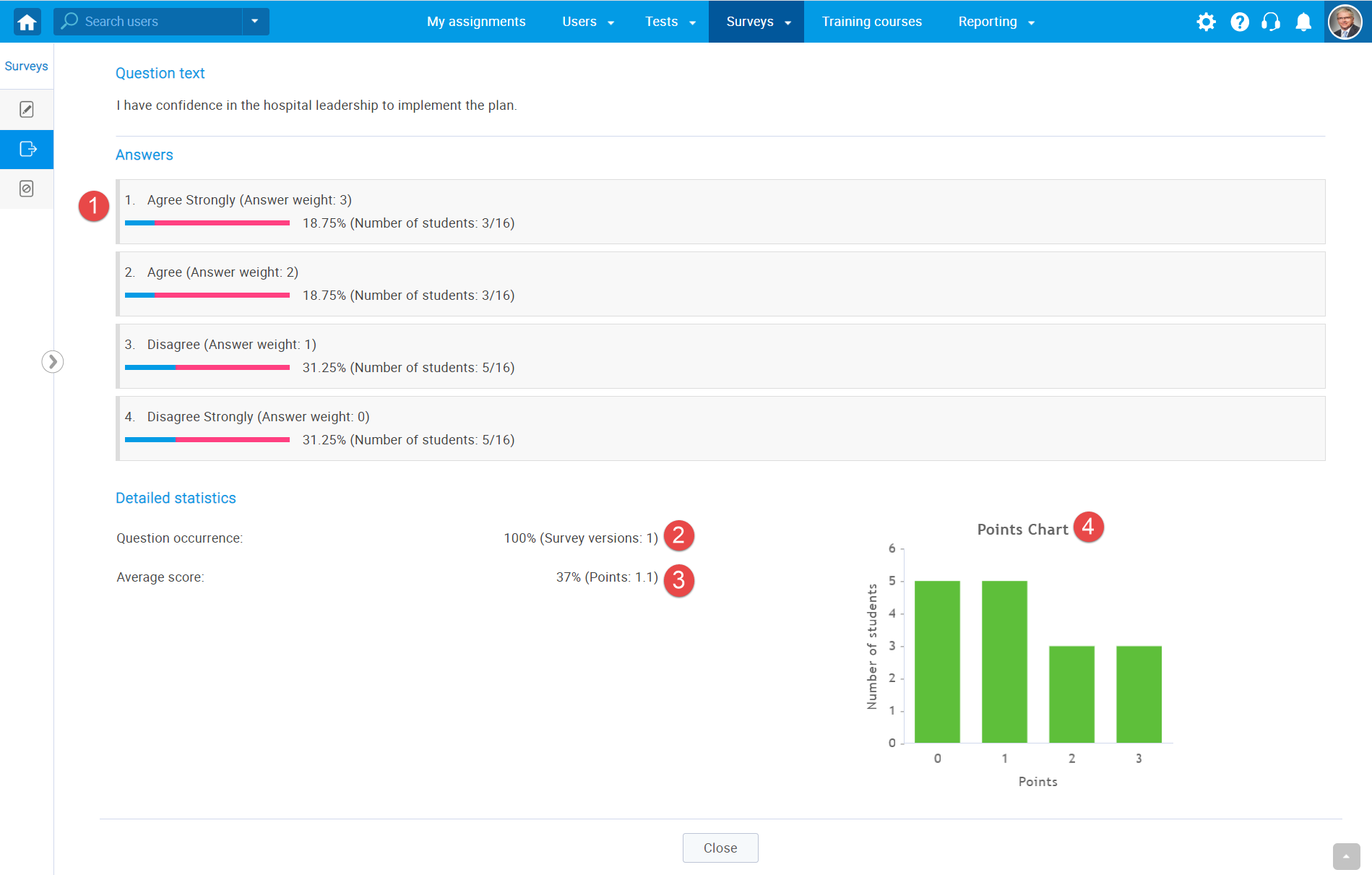
The survey manager can edit survey settings, add new candidates, proctors and managers, create survey sessions, and monitor the progress of each candidate. Also, a manager can create survey reports and view question's statistics.
To add new managers, follow these steps:
- Click the "Assign managers" button.
- Select the users you want to add.
- Click the "Confirm" button.

By clicking the "Export as Excel" or "Export as PDF" button, you can download the list of managers.
To delete the existing managers, follow these steps:
- Select the users you want to delete.
- Click the "Remove selected" button and accept the deleting in a confirmation dialog.
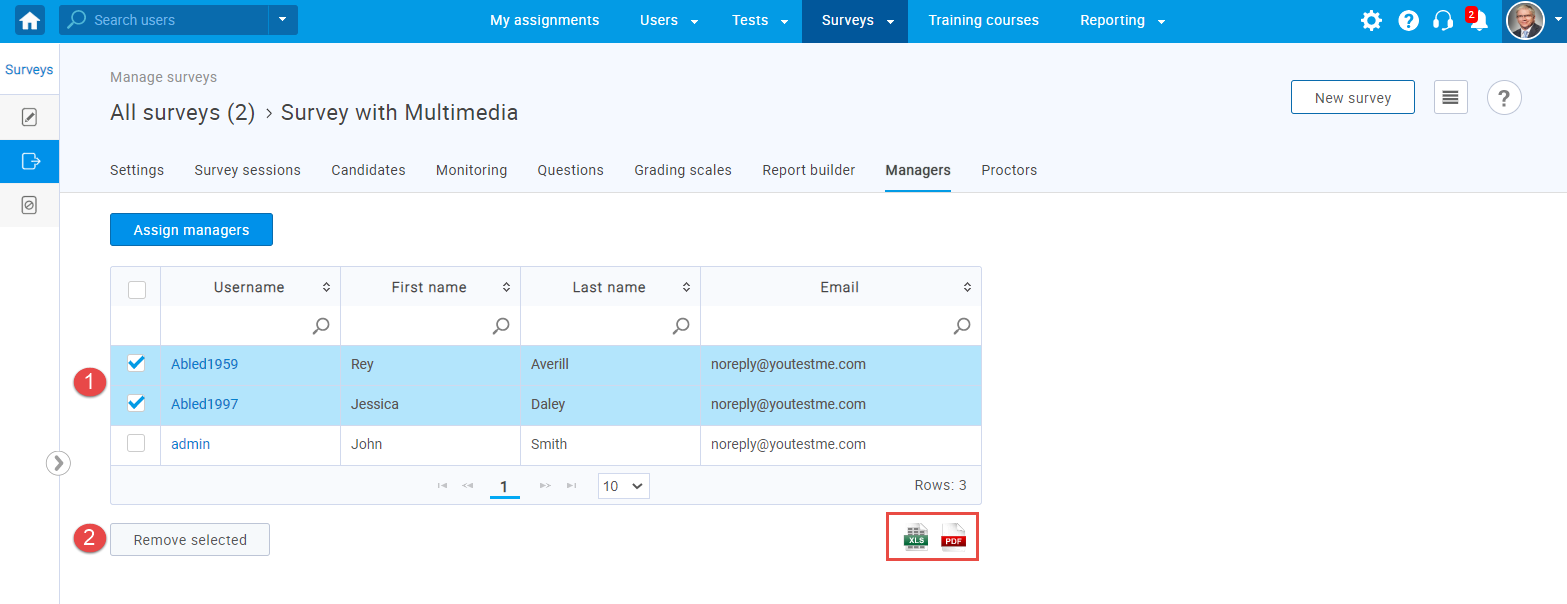
In this tab, you can assign or remove the users as proctors. The user who has the default "Proctor" role or who is assigned as a survey proctor will only be able to monitor the candidates' progress, while a manager can edit the survey, create new sessions, etc.
A proctor can monitor the candidates’ progress in the "Monitoring" tab and view previous attempts, candidates’ reports or allow survey retaking in the "Candidates" tab.
If a user does not have all proctor permissions (less than the default Proctor role), he can not monitor the survey.
If you want a proctor to have more permissions, you can create a new proctor role or update the existing one. For more information on how to create and edit user roles, please visit Roles and permissions.
To add a new proctor, follow these steps:
- Select the session you want to add a proctor to.
- Click the "Assign proctors" button.
- Select the proctor you want to add.
- Click the "Confirm" button.
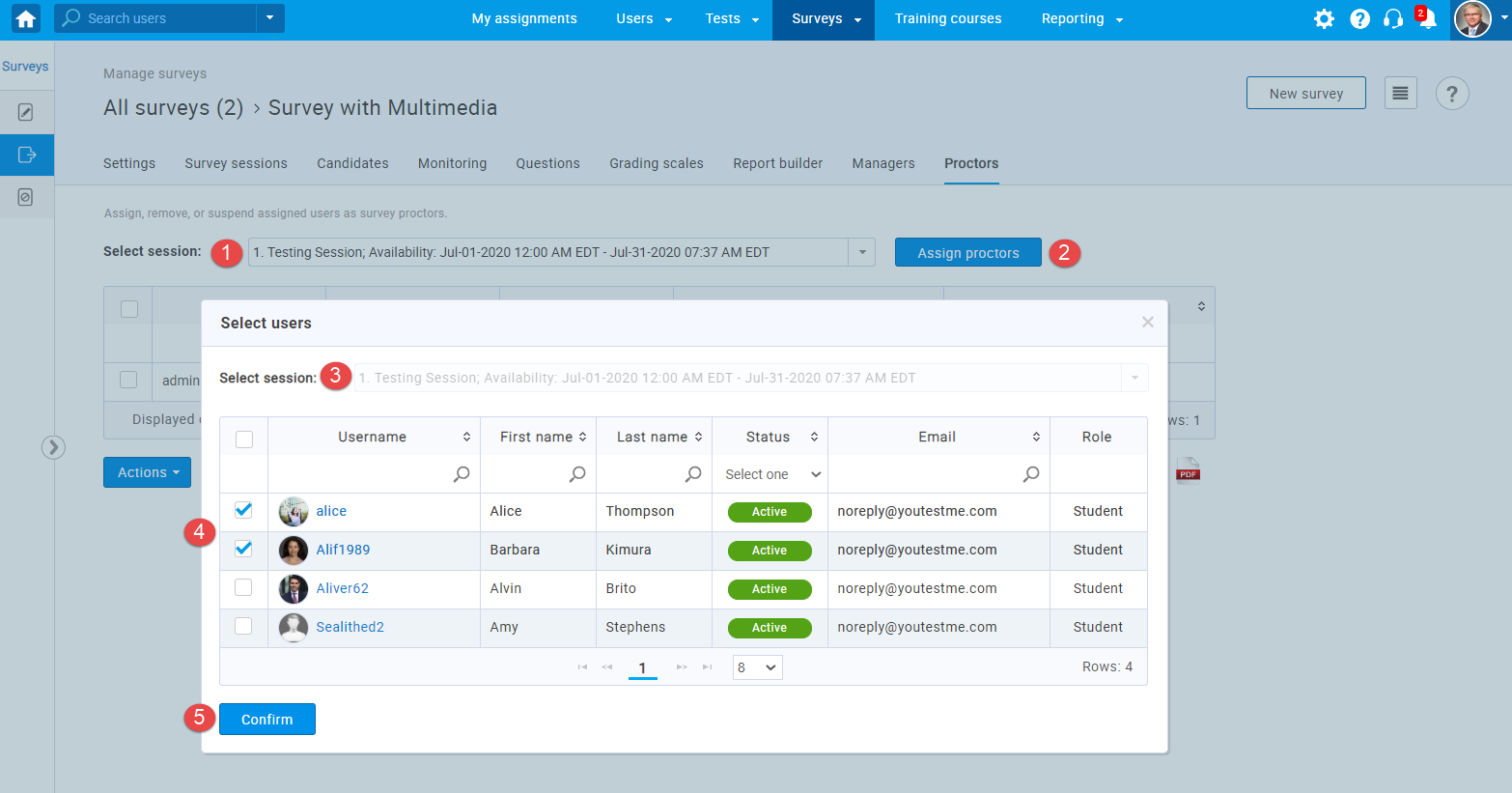
By clicking the "Export as Excel" or "Export as PDF" button, you can download the list of proctors.
To remove a proctor:
- Select the users you want to remove.
- Click the "Remove selected" button.
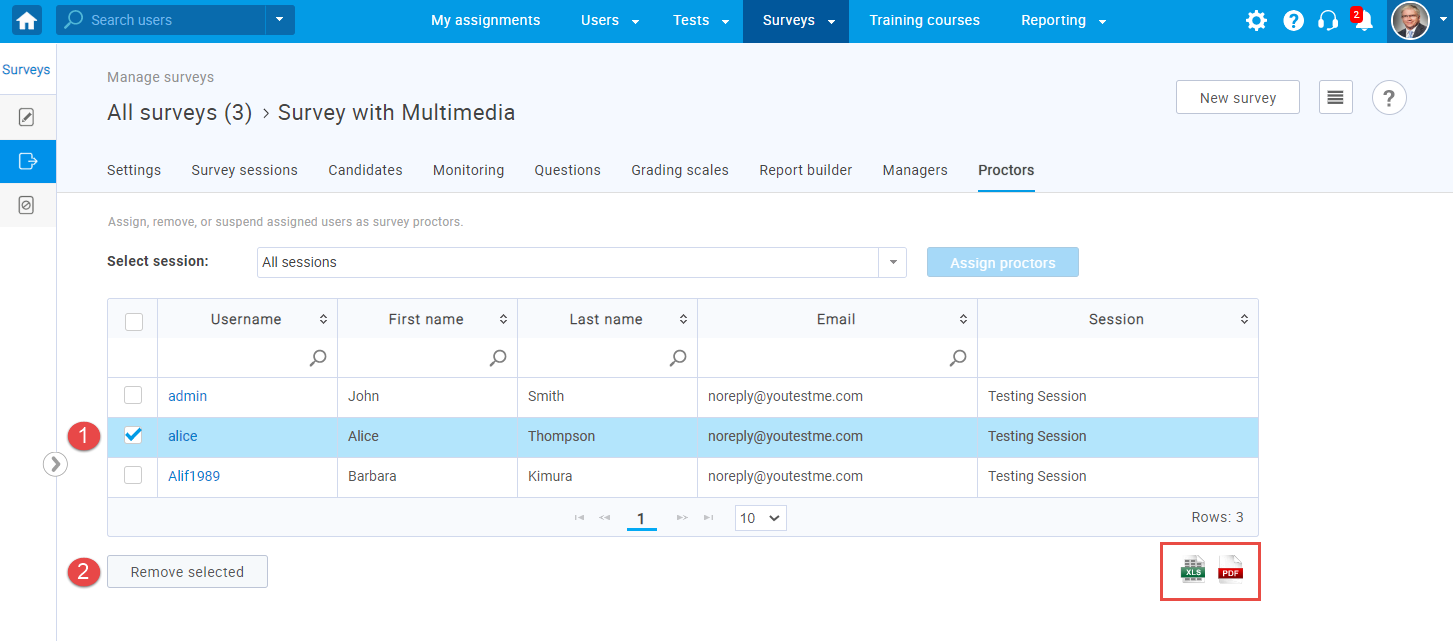
A grading scale enables you to present the survey results in a standardized way, e.g. on a scale from A to F. For more information on how to change existing and create new grading scales, please visit Surveys/Grading scales.
A grading scale can be changed while the survey is in the draft version. Once you publish the survey, it is no,longer possible to change the scale.
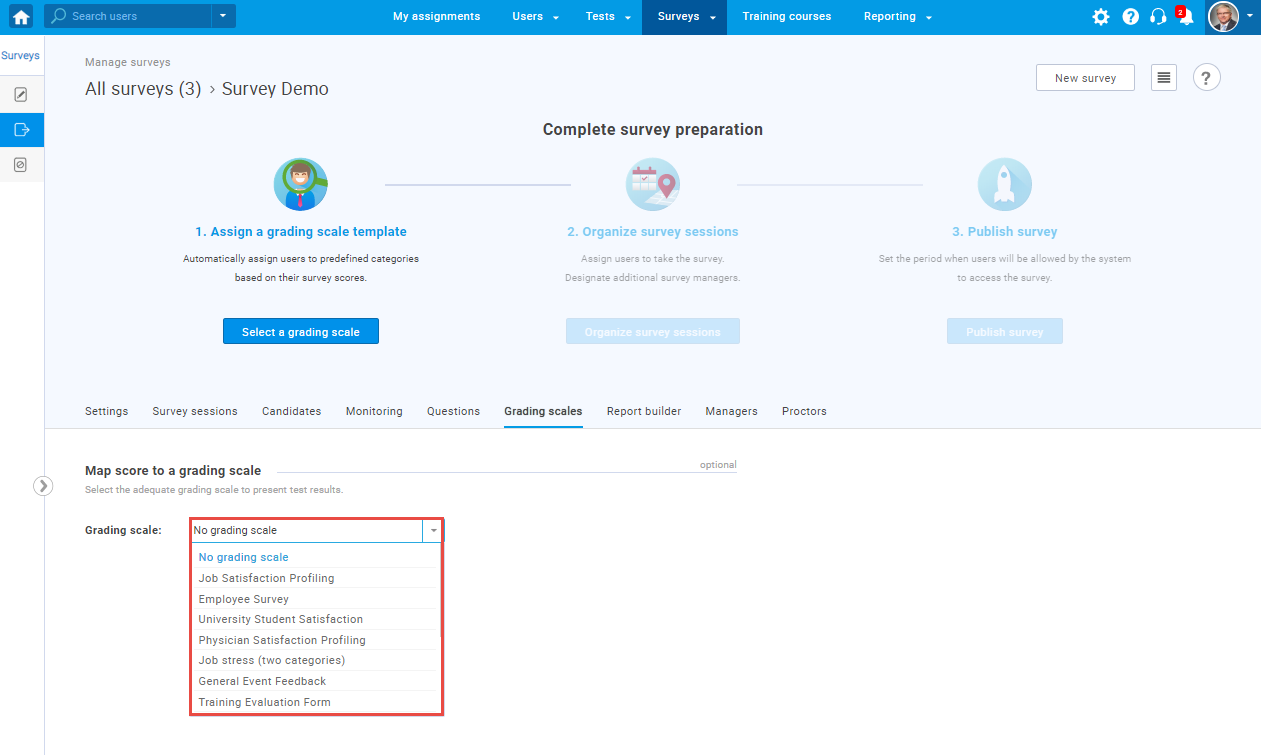
Report builder allows you to obtain a detailed insight into survey statistics and create flexible and unique reports by applying advanced search filters. This feature also enables the efficient comparison of tests/surveys and analysis of individual survey items.
- You can load the report columns' settings from a saved report template.
- You can create a new custom report by checking the options from the list. Each selected option will be featured as a column in the report table.
- The advanced search allows you to build structured queries. The simple filter displays the results according to the chosen
column, criteria, and value. The group filter represents a conjunction (AND) or disjunction (OR) of more filters. Negation can be
applied to any filter.
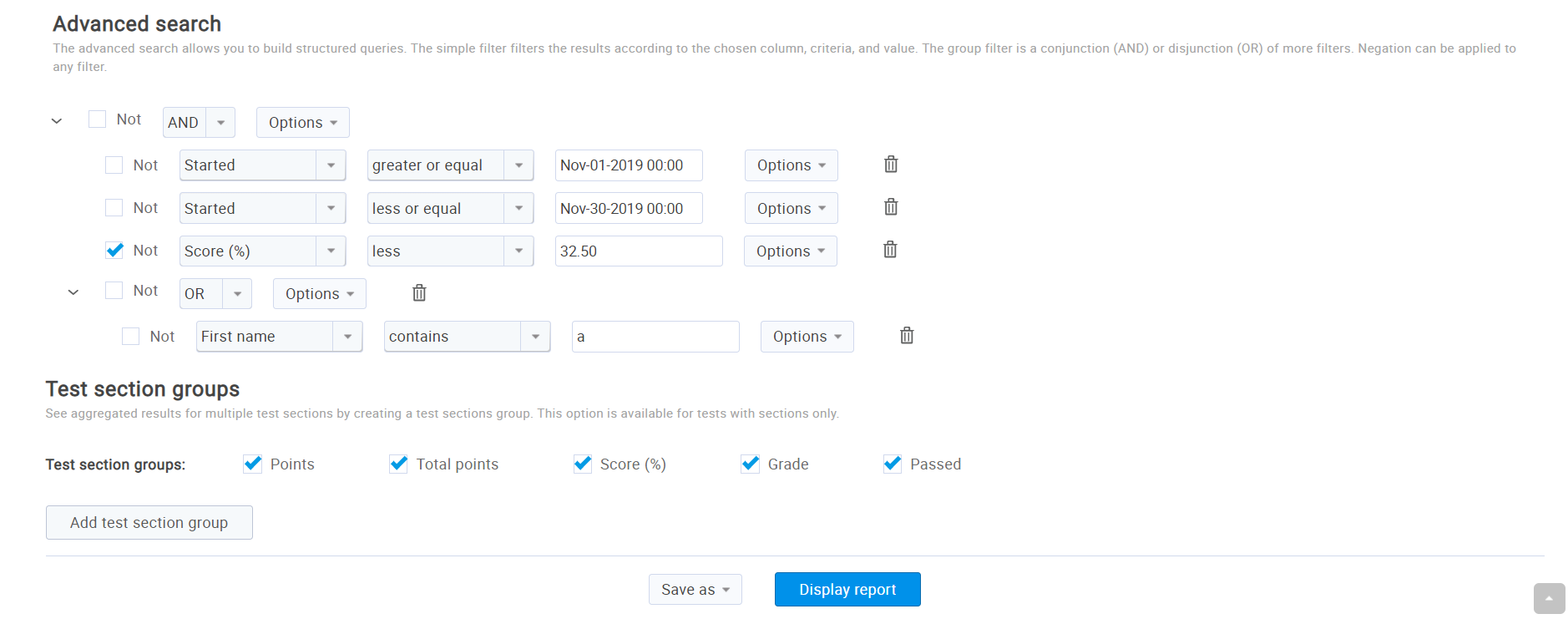 For expample, the query from the picture above will produce the report which will include all survey attempts taken between 1st and
31st March 2020, having scores not less than 25% (greater than 25%) and whose takers either have the first name
Daisy or are not born after 7th March 1998.
For expample, the query from the picture above will produce the report which will include all survey attempts taken between 1st and
31st March 2020, having scores not less than 25% (greater than 25%) and whose takers either have the first name
Daisy or are not born after 7th March 1998.
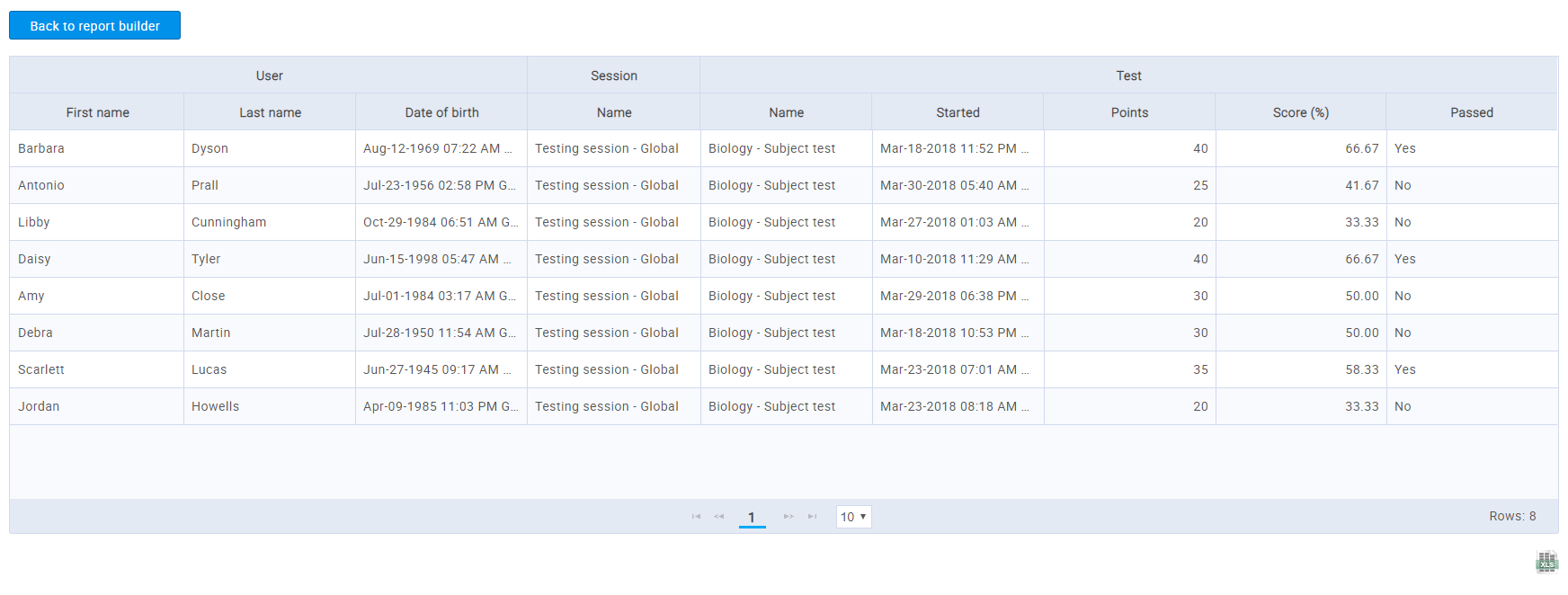
- You can save the report settings as a new report template or update the existing report template by clicking the Save as... button. Then you can choose if you want to create new or update exsisting one.
- Click the New report template to save the report settings as a new template. Enter the name of the template in a dialog box. To confirm the input, click the "Save" button or discard it by clicking the "Cancel" button.
- Click on the Existing report template to save the report settings to the existing report template. Choose the desired report template you want to update in the dialog box. If the selected template is already loaded (see 1. step), it will be chosen by the default. You can change the name of the selected template by editing the Name field. To confirm the input, click the "Save" button or discard it by clicking the "Cancel" button.
- After you configure the report settings, click the "Display report" button to see the report you have made.
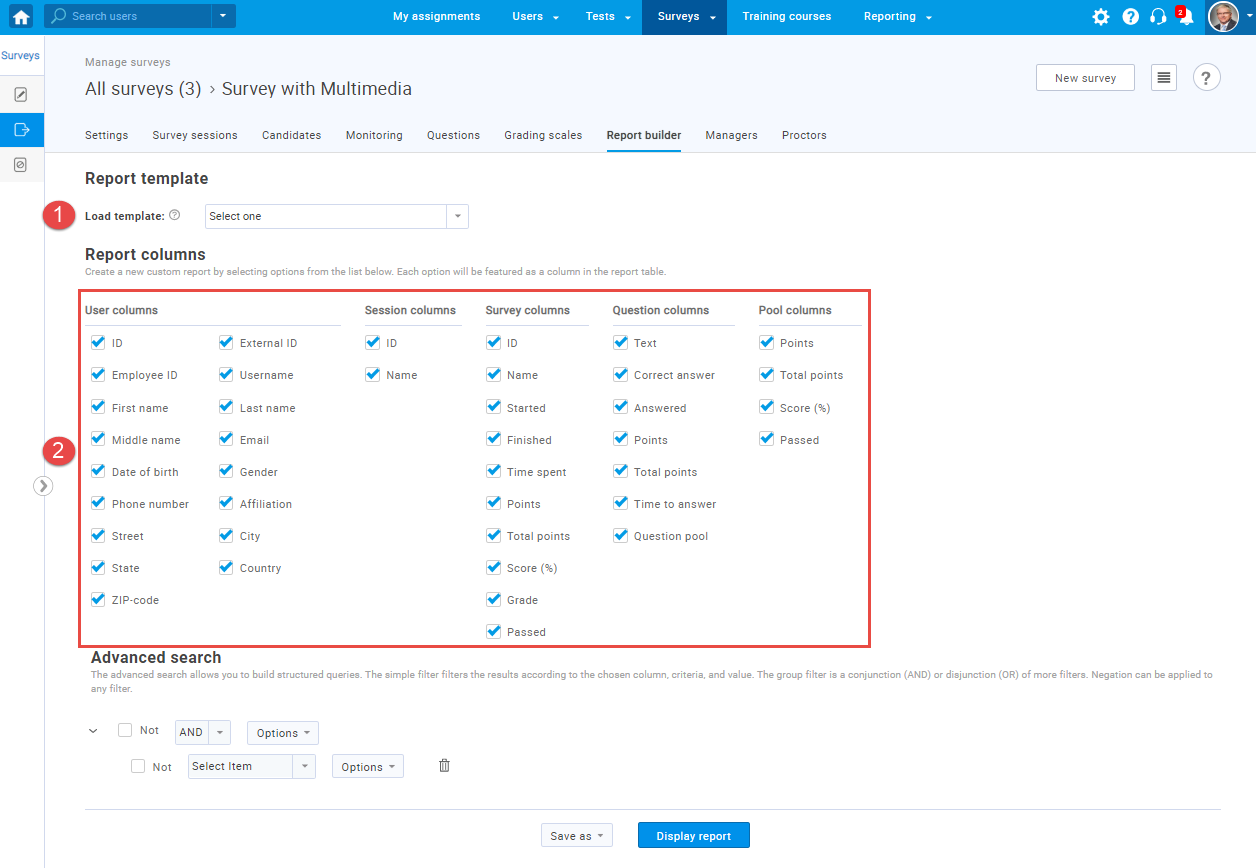
Note: Only selected columns will be saved, excluding the advanced search (queries).



